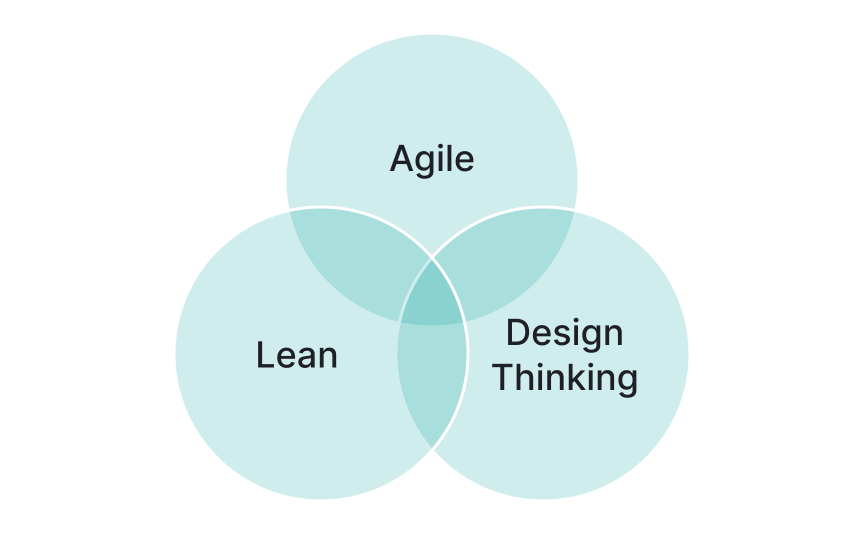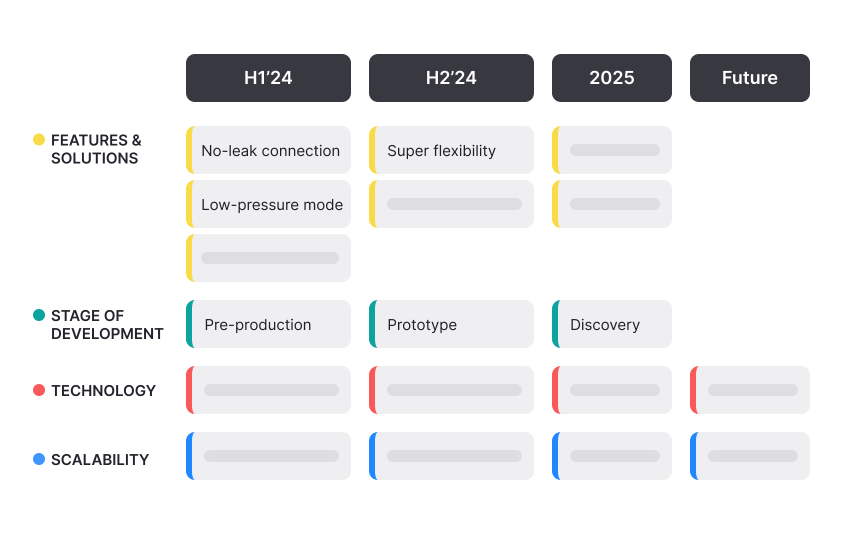Agile Mindsets
Develop an agile mindset to transform your approach to product development and team collaboration.
The agile mindset fundamentally changes how teams approach their work. It values flexibility and collaboration over rigid processes and isolated tasks. While many teams focus on implementing agile practices, the true power lies in adopting the thinking patterns behind them. This mindset welcomes uncertainty, treats feedback as a gift, and views failure as a learning opportunity. Agile thinking blends naturally with other modern approaches like lean and design thinking. They all share roots in breaking down barriers and responding to change.
Unlike traditional environments where work passes from one specialized department to another, agile teams work side by side, constantly communicating and adapting. Product managers, designers, and developers who embody agile thinking often create better products while fostering team satisfaction and meeting customer needs more effectively. A shift in mindset serves as a powerful tool for navigating the complex challenges of modern product development.
The agile mindset represents a fundamental shift in how teams approach product development, prioritizing adaptability, collaboration, and continuous improvement over rigid planning. This mindset embraces change as an opportunity rather than a disruption, viewing requirements evolution as a natural part of creating valuable products. Unlike process-centric approaches, the agile mindset emphasizes delivering value through incremental progress, validated learning, and frequent customer feedback. It recognizes that complex problems require emergent solutions that unfold through exploration rather than comprehensive upfront planning.
At its core, this mindset values working solutions over exhaustive documentation, team collaboration over siloed handoffs, and customer engagement over contractual adherence. The agile mindset also embodies empiricism, making decisions based on observable evidence rather than theoretical plans or untested assumptions. For product and design teams, adopting this mindset means balancing creativity with pragmatism, maintaining focus on user problems while remaining flexible about specific solutions, and embracing the uncertainty inherent in creating innovative products.
Pro Tip: Start cultivating an agile mindset by asking "What value does this create?" before beginning any significant work task. This simple question often reveals surprising insights about priorities.
Many organizations adopt agile methodologies but struggle to see real benefits because they follow practices without developing the underlying mindset. Frameworks like Scrum provide helpful structure through short work cycles, clear roles, and regular team meetings that support collaboration and learning. However, these practices often become empty routines when teams don't understand the thinking patterns that make them valuable.
The agile mindset focuses on outcomes over outputs, caring more about delivering customer value than just following a process or completing features. This thinking pushes teams to question assumptions, remove unnecessary work, and constantly adjust their approach based on what they learn.
While methodologies give practical guidance, the mindset determines how well teams will apply these frameworks when facing challenges. Teams with a strong agile mindset will thoughtfully adapt standard practices when they find better approaches for their specific situation. The most successful organizations understand that methodologies should support the mindset, using them as flexible tools rather than strict rules.
Pro Tip: When a methodology feels constraining rather than enabling, pause to discuss the principles behind the practice. Often, teams discover better ways to achieve the same goals.
The difference between agile and fixed mindsets strongly shapes how teams approach software development. A fixed mindset treats requirements as set in stone, sees plans as promises, and views changes as problems that should be avoided. Teams with this mindset often resist feedback, defend their initial decisions even when new information appears, and judge success by how well they stuck to the original plan.
In contrast, an agile mindset sees software development as a learning process where requirements evolve as both the team and customers gain understanding. This mindset welcomes changes as opportunities to build better products, values feedback as helpful input rather than criticism, and measures success by the value delivered to users.
The agile mindset also changes how teams handle uncertainty. While fixed thinking tries to remove uncertainty through detailed planning, agile thinking accepts that uncertainty is normal and develops ways to learn quickly through experiments, prototypes, and frequent releases. This core difference affects every part of how teams work.
Pro Tip: Notice when team members use phrases like "that wasn't in the requirements" or "we can't change now." These often signal fixed-mindset thinking that limits adaptability.
The agile mindset is built on fundamental values that guide how teams think and behave.
- Adaptability stands as a core value, with teams embracing change instead of resisting it.
- Collaboration is equally important, with team members working together closely rather than in isolation.
- The learning value represents the agile mindset's connection to growth mindset principles, where feedback and even failure become sources of improvement.
- Customer focus keeps teams centered on delivering genuine value rather than just following processes.
- The value of iterative thinking encourages working in small, manageable cycles rather than trying to deliver everything at once.
These values align with broader concepts like lean thinking and
Pro Tip: Evaluate team decisions against these core values. When facing tough choices, asking "Which option best supports our ability to adapt?" can provide helpful clarity.
The agile mindset shares significant common ground with other progressive approaches to product development. There aren't clear boundaries between agile, lean, and
All these mindsets aim to break down boundaries and walls between team members and functions. These approaches all emphasize working side-by-side in cross-functional teams rather than working in isolation and "throwing things over the wall." For those uncomfortable with highly communicative and collaborative environments, organizations that adopt these mindsets might not be the right fit. The boundaries between these mindsets intentionally blur, allowing teams to draw from multiple approaches depending on their specific challenges.
Product managers who embrace agile thinking shift from controlling roadmaps to facilitating value discovery and delivery. This represents a change from "owning the roadmap" to "facilitating value delivery." Agile product managers develop hypotheses about user needs and business opportunities, then test these hypotheses through experiments,
This approach requires comfort with uncertainty and the ability to adapt based on new information. When prioritizing work, they focus primarily on customer outcomes rather than feature completeness. Agile product managers collaborate with their team to prioritize customer value over deadlines and accept that requirements will evolve as they learn more.
Pro Tip: Frame product ideas as hypotheses rather than requirements: "We believe [feature] will achieve [outcome]" invites testing rather than just implementation.
Agile-minded designers treat design as a collaborative, evolving process that's tightly integrated with development. This represents a shift from designing everything up front to co-creating iteratively.
What agile designers practice in their work:
- Working alongside developers during sprints
- Using design sprints and rapid prototyping to validate ideas quickly
- Valuing user feedback over design perfection.
- Iterating based on what the team and users learn.
This collaborative approach rejects the idea of handoffs between team members. Rather than creating comprehensive deliverables in isolation, designers work iteratively alongside developers and product managers. They understand that design decisions represent hypotheses that need testing with users. This requires flexibility about fidelity, creating high-definition mockups only when the additional detail adds value to the learning process. For designers in software companies, this means they should never operate like an agency separated from product and development teams.
Pro Tip: Start design explorations at the lowest fidelity needed to answer your current questions. Sketches before wireframes, wireframes before mockups, and mockups before detailed specs.
Moving to an agile mindset often meets resistance from teams that are comfortable with their current ways of working. As the mindset drives the practices, applying agile methods without the right thinking behind them rarely succeeds. People typically resist agile for several reasons:
- They worry about losing control
- They fear unpredictability
- They want to protect their specialized role boundaries
The best way to address this resistance isn't by forcing compliance but by understanding the real concerns beneath it. When teams worry about losing control, showing how faster feedback actually gives them more influence can change their perspective. When people feel attached to specialized roles, demonstrating how collaboration expands their impact often helps them see beyond their current boundaries. It's worth noting that the agile mindset fundamentally requires comfort with communication and collaboration. There's simply no way to be agile while working in isolation or passing work over walls between departments.
Pro Tip: When facing resistance, try to understand the underlying concerns rather than debating methodology. Ask "What specifically worries you about this approach?" to address root causes.
Agile thinking creates truly collaborative environments where cross-functional teams solve problems together. This requires a fundamental shift from isolated work to side-by-side collaboration.
Key elements of agile collaborative environments include:
- Physical space: Shared team areas, visual management tools, and spaces designed for both focused work and group sessions
- Communication patterns: Less formal
documentation , more direct conversation, and paired work sessions[1] - Decision-making: Moving from hierarchical approvals to empowered teams making decisions at the appropriate level
- Team structure: Cross-functional teams working on end-to-end solutions rather than specialized departments with handoffs
For organizations adopting agile, there's no escaping the highly communicative and collaborative nature of this work environment. This means people who prefer working independently with minimal interaction may struggle to fit within these organizations.
Pro Tip: Schedule regular pair-working sessions between different disciplines, like design and development. Even an hour spent solving problems together builds collaboration more effectively than documentation.
Measuring the agile mindset's impact requires looking beyond traditional metrics to assess team effectiveness and business outcomes.
Key measurement areas include:
- Cycle time: How quickly ideas transform into features
- Team engagement: Satisfaction levels and participation
- Learning capacity: How teams respond to setbacks and feedback
- Customer metrics: Adoption, satisfaction, and retention
- Value delivery: Problem resolution versus feature completion
Teams with strong agile mindsets typically expect to learn and adapt continuously, view failure as valuable feedback rather than something shameful, focus on progress over perfection, and prioritize customer value over process adherence. The most meaningful measurement combines quantitative data with qualitative insights from team retrospectives, customer interviews, and usage observation.
Pro Tip: Choose a small set of metrics that measure outcomes, not just outputs. Track how quickly customer problems are solved rather than how many features are shipped.
Similar lessons

Agile Methodologies

What is Agile?



















